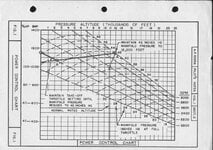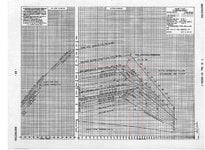Shortround6
Lieutenant General
In a chart on page 124 in "Vees for Victory" they have a chart for the V-1710-33 The chart is dated 12-5-39.
the chart is something like this one.

EXCEPT, it shows the graph going all the way to sea level. It is also in finer detail and has standard latitude and temperature along the bottom.
The engine is shown as making 1090hp/3000rpm at 13,200ft using 38.9in. in notes similar to the ones in the chart using as the illustration.
The chart shows that the engine will make 1040hp at 14,200ft.
The engine will also make 1150hp at around 11,500ft. using 42in?
The engine will also make just under 1700hp at sea level using 61in map.
There was considerable argument about the C-33 between Allison and the Air Corp. Allison wanted the 1040hp rating and the Air Corp wanted the 1090hp rating. The Air Corp got the 1090hp rating but they broke of lot engines and Allison had to rebuild 277 engines and the engines still flying were derated to 2770rpm and 950hp at 8,000ft. The modified engines were rated at 1090hp.
Now please note that the 1040hp rating does show up in quite a few books/sources about the P-40.
BTW the chart shows the C-33 engine was good for about 1480hp at 42-4300ft using 54in and 1580hp at 2500ft using 58in which is not too bad considering changes in manifolds, backfire screens and a few other minor differences.
These are test results and are NOT useable for service use
Now even climbing or putzing along at 180mph there is going to be some RAM effect.
Ram effect in theory goes up with the square of the speed. However RAN effect in the engine charts also take into account any limitations in the intake duct duct or problems with the intake.
Also note that P-40s and P-39s (and perhaps Allison P-51) had to have their exhaust pipes modified to get the full effect of the WER performance. The Exhaust pipes were too small and were choking the engine, the exhaust outlets had to be opened up.
Corrected 1580hp at 2500ft in C033 chart
the chart is something like this one.
EXCEPT, it shows the graph going all the way to sea level. It is also in finer detail and has standard latitude and temperature along the bottom.
The engine is shown as making 1090hp/3000rpm at 13,200ft using 38.9in. in notes similar to the ones in the chart using as the illustration.
The chart shows that the engine will make 1040hp at 14,200ft.
The engine will also make 1150hp at around 11,500ft. using 42in?
The engine will also make just under 1700hp at sea level using 61in map.
There was considerable argument about the C-33 between Allison and the Air Corp. Allison wanted the 1040hp rating and the Air Corp wanted the 1090hp rating. The Air Corp got the 1090hp rating but they broke of lot engines and Allison had to rebuild 277 engines and the engines still flying were derated to 2770rpm and 950hp at 8,000ft. The modified engines were rated at 1090hp.
Now please note that the 1040hp rating does show up in quite a few books/sources about the P-40.
BTW the chart shows the C-33 engine was good for about 1480hp at 42-4300ft using 54in and 1580hp at 2500ft using 58in which is not too bad considering changes in manifolds, backfire screens and a few other minor differences.
These are test results and are NOT useable for service use
Now even climbing or putzing along at 180mph there is going to be some RAM effect.
Ram effect in theory goes up with the square of the speed. However RAN effect in the engine charts also take into account any limitations in the intake duct duct or problems with the intake.
Also note that P-40s and P-39s (and perhaps Allison P-51) had to have their exhaust pipes modified to get the full effect of the WER performance. The Exhaust pipes were too small and were choking the engine, the exhaust outlets had to be opened up.
Corrected 1580hp at 2500ft in C033 chart
Last edited:


